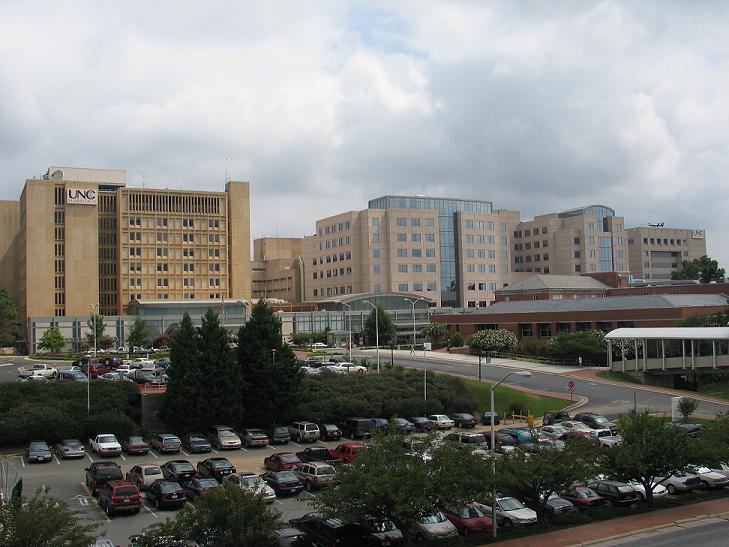- University of North Carolina School of Medicine
UNC-Chapel Hill programs
name = School of Medicine

image_size = 250
caption = N.C. Memorial Hospital and N.C. Children's Hospital
location = Chapel Hill,North Carolina
established = 1879
dean = William L. Roper
website = [http://www.med.unc.edu/ School of Medicine] The University of North Carolina School of Medicine is a professional school within theUniversity of North Carolina at Chapel Hill . It offers aDoctor of Medicine degree along with combined Doctor of Medicine /Doctor of Philosophy or Doctor of Medicine /Master of Public Health degrees.It is one of the top ranked medical schools in the country: the 2009 US News and World Report ranks the school 2nd in primary care and 19th in research. In 2007, the school received $298 million in research funding, with approximately two-thirds coming from the
National Institutes of Health [http://www.unc.edu/news/archives/aug07/researchfunding080307.html Total research revenues top $610 million] August 3, 2007.] .Curriculum
First Year
The first year curriculum consists of four blocks covering the basic medical sciences. Each block combines daily lectures by faculty from diverse fields, and therefore provides a highly integrated curriculum. The first block, titled "Molecules to Cells", includes Cellular and Molecular Biology, Biochemistry, and Genetics. The second, "Structure and Development", is primarily an Anatomy course (including human cadaver dissection), but also covers Embryology (the "source" of anatomy) and basic Radiology (a clinically important application of anatomic knowledge). The third block is "Integrative Function and its Cellular Basis", which is a multisystem Physiology and Histology course which also revisits Cellular and Molecular Biology. This allows students to gain a better understanding of how the microscopic structure of a tissue affects its physiologic function. The final block, "Host Defense and Microbial Pathogens", covers Microbiology, Virology, and Immunology. In addition to the four core blocks, students have weekly "Medicine and Society" small groups, where they discuss the role and effects of health care in our society. They also apply their fledgling medical knowledge through occasional case study small groups, called the "Clinical Applications Course" or "CAC." First-year students learn basic physical exam skills via the weekly "Introduction to Clinical Medicine" small groups, and shadow physicians throughout North Carolina during two "Community Weeks." In between first and second year, many students conduct clinical or medical science research at UNC or at other institutions through several grants. Others travel with UNC physicians to clinics in South America, Africa and Asia.
econd Year
The second year begins with the "Tools for Diagnosis and Therapy" course, which gives students a basic understanding of the various machines and technologies available to aid physical diagnosis (ie, CT scanners, MRI, etc). The second year curriculum is divided into organ system blocks that are 3-8 weeks in length. As in first year, these blocks offer a highly integrated curriculum; each block covers the physiology, pathology, diagnosis, and treatment of that organ system. Each semester ends with a capstone "Clinical Cases" course, which allows students to fully exercise their knowledge of diagnosis and therapy. Students also participate in "Health & Social Science Selectives" that meet once a week for half the year. Clinical exposure expands through the continuation of the "Introduction to Clinical Medicine" small groups and an additional three Community Weeks. Lastly, students receive training in the conduction and critical reading of medical research through the "Clinical Epidemiology" course. At the end of second year, students take the USMLE Step 1 Exam.
Clinical Years
The third and fourth years take place in clinics at UNC Hospitals (~60% of the year) and other institutions throughout the state (~40% of the year). The third year focuses on core specialties of medicine (Psychiatry, Neurology, Family Practice, Obstretrics and Gynecology, Surgery, Advanced Cardiac Life Support, Internal Medicine, and Pediatrics), while the fourth year allows students to gain experience in specialties of their interest through numerous electives. Every fourth-year student completes an "Acting Internship", a period in which the student assumes the role of an intern in taking full control of the care of patients (though a physician maintains a supervisory role). Many students take time off between these two years to pursue a Master of Public Health degree or conduct research sponsored by several institutional and national fellowships.
Facilities
Hospitals
The
UNC Health Care complex is situated on the southern tip of the UNC campus, and comprises a number of healthcare facilities. The four core hospitals are the UNC Memorial Hospital, the UNC Children's Hospital, the UNC Womens' Hospital, and the UNC Neurosciences Hospital. Together these buildings offer over 700 inpatient beds and comprise a Level 1 referral center. A fifth core hospital, the North Carolina Cancer Hospital, is slated to open in 2009, and will add outpatient clinic space and 50 additional beds. These hospitals are surrounded by satellite facilities in which medical research and outpatient care are carried out. They include the Ambulatory Care Center, NC Clinical Cancer Center, and the Family Practice building.AHEC Centers
North Carolina has a unique system of Area Health Education Centers across the state. These allow UNC medical students to spend clinical time in widely varied communities, from tertiary care in Charlotte to rural primary care in the Western mountains. Additionally, the AHEC centers maintain lists of local physicians who are interested in educating medical students, and UNC students spend substantial time working with doctors in various private practices.
References
External links
* [http://www.med.unc.edu/ University of North Carolina School of Medicine Homepage]
* [http://www.usnews.com/ US News and World Report]
Wikimedia Foundation. 2010.
